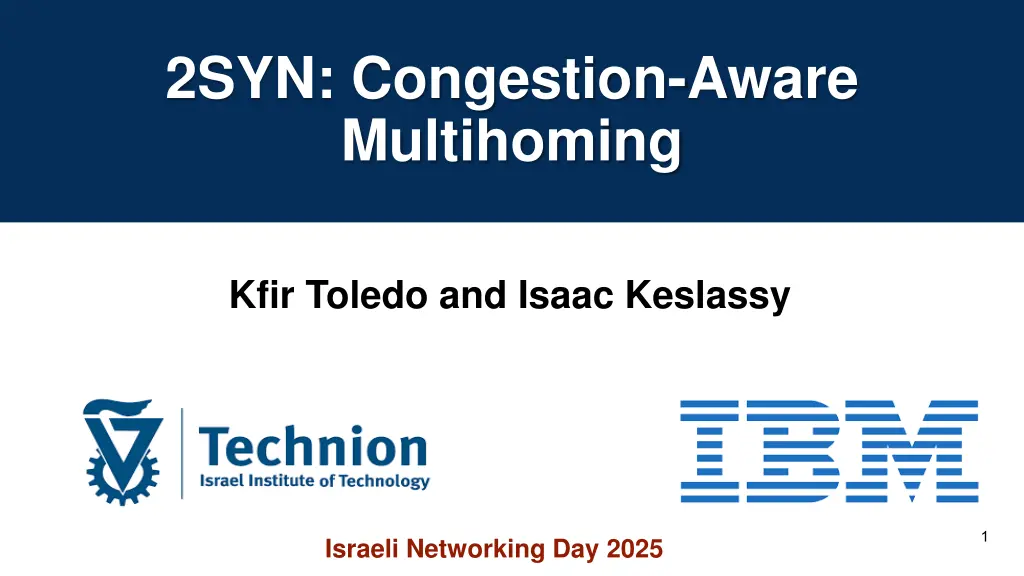
Congestion-Aware Multihoming Algorithm for Router Load Balancing
Explore the 2SYN congestion-aware multihoming algorithm designed to optimize router load balancing for new flows, addressing the fundamental problem of how routers route flows efficiently. Evaluate current alternatives and learn about the innovative algorithm's design goals and performance metrics.
Download Presentation

Please find below an Image/Link to download the presentation.
The content on the website is provided AS IS for your information and personal use only. It may not be sold, licensed, or shared on other websites without obtaining consent from the author. If you encounter any issues during the download, it is possible that the publisher has removed the file from their server.
You are allowed to download the files provided on this website for personal or commercial use, subject to the condition that they are used lawfully. All files are the property of their respective owners.
The content on the website is provided AS IS for your information and personal use only. It may not be sold, licensed, or shared on other websites without obtaining consent from the author.
E N D
Presentation Transcript
2SYN: Congestion-Aware Multihoming Kfir Toledo and Isaac Keslassy 1 Israeli Networking Day 2025
Multihoming Problem Fundamental problem: How should router R route a new flow? R LTE D S Internet Source Router DSL 2 Evaluation Conclusion Motivation Algorithm
Multihoming Problem Our goal in this talk: Provide a general congestion-aware flow load- balancing algorithm given any arbitrary destination. 3 Evaluation Conclusion Motivation Algorithm
Multihoming Problem Current alternatives: Static fail-over algorithm Not congestion-aware Static load-balancing algorithm Not congestion-aware MPTCP(Multipath TCP) Requires D to be compatible 4 Evaluation Conclusion Motivation Algorithm
2SYN Algorithm Design Goals: Simplicity (standard TCP protocol) Lightweight (no special hardware) Only local knowledge in R (no tunnels) Performance Dynamic 5 Evaluation Conclusion Motivation Algorithm
2SYN Algorithm SYN LTE ???(?) D S R Internet ??(?) ??(?) ???(?) Source Router DSL 6 Evaluation Conclusion Motivation Algorithm
2SYN Algorithm SYN LTE ???(?) D S Internet SYN ??(?) ??(?) ???(?) Source Router Active Flows ???(?) ???(?) DSL 7 Evaluation Conclusion Motivation Algorithm
2SYN Algorithm LTE SYN- ACK ACK SYN- D S R Internet Source Router Active Flows ???(?) ???(?) DSL 8 Evaluation Conclusion Motivation Algorithm
2SYN Algorithm LTE RST ???(?) D S Data Data Data Data Data R Internet ???(?) Source Router Active Flows Active Flows ???(?) ???(?) ???(?) DSL 9 Evaluation Conclusion Motivation Algorithm
Lab Evaluation Propagation delay Queuing delay LTE ???(?) D S Internet R ??(?) ??(?) ???(?) Source Router Transmission delay Bandwidth drop DSL 10 Evaluation Conclusion Motivation Algorithm
Lab Evaluation Propagation delay LTE Queuing delay ???(?) D S Internet R ??(?) ??(?) ???(?) Source Router Transmission delay Bandwidth drop DSL 11 Evaluation Conclusion Motivation Algorithm
Evaluation: Propagation delay Evaluation setup: High RTT: 120ms, Low RTT: 80ms, average of 20 experiments with a 1MB file 12 Evaluation Conclusion Motivation Algorithm
Lab Evaluation Propagation delay Queuing delay LTE ???(?) D S Internet R ??(?) ??(?) ???(?) Source Router Transmission delay Bandwidth drop DSL 13 Evaluation Conclusion Motivation Algorithm
Lab Evaluation: Queueing delay Evaluation setup: BW: 300Mbps, RTT: 120ms, average of 20 experiments with a 1MB file 14 Evaluation Conclusion Motivation Algorithm
Lab Evaluation Propagation delay Queuing delay LTE ???(?) D S Internet R ??(?) ???(?) ??(?) Source Router Transmission delay Bandwidth drop DSL 15 Evaluation Conclusion Motivation Algorithm
Lab Evaluation: Transmission delay 100MB file: no background traffic 100MB file: with background traffic Evaluation setup: 1. Low BW: 30Mbps, High BW: 300Mbps, average of 20 experiments, no background traffic 2. Low BW: 30Mbps, High BW: 300Mbps, average of 20 experiments, with background traffic 16 Background traffic : ten flows limited to 30Mbps each Evaluation Conclusion Motivation Algorithm
Lab Evaluation Propagation delay Queuing delay LTE ???(?) D S Internet R ??(?) ???(?) ??(?) Source Router Transmission delay Bandwidth drop DSL 17 Evaluation Conclusion Motivation Algorithm
Lab Evaluation: Resilience to Bandwidth Drop Evaluation setup: 1. Path 1 remains constant at 100 Mbps 2. Path 2 drops from 300 Mbps to 30 Mbps after downloading 40% of the files 3. Sending 20 files of 100 MB each. 18 Evaluation Conclusion Motivation Algorithm
Real World Experiments: LTE vs DSL Web search: Download link 30MB file: Upload link Evaluation setup: Technion to London Path1: 4G LTE Path2: DSL link 19 Evaluation Conclusion Motivation Algorithm
Real World Experiments: LTE vs DSL Web search: Download link 30MB file: Upload link Evaluation setup: Technion to London Path1: 4G LTE Path2: DSL link Bandwidth drop for the DSL link 20 Evaluation Conclusion Motivation Algorithm
Why not Learning? Multi-Armed Bandits' problem ? - greedy algorithm Upper confidence bound (UCB1) Thompson sampling Why not? Less reactive to changes 21 Evaluation Conclusion Motivation Algorithm
Why not Learning? With bandwidth drop Constant: without bandwidth drop Evaluation setup: 1. 5 flows, Low BW: 200 Mbps, High BW:300 Mbps, 50 files of 10MB 2. 5 flows, Low BW: 200 Mbps, High BW:300 Mbps, 20 files of 200MB, with bandwidth drop 22 Evaluation Conclusion Motivation Algorithm
Conclusion Simple 2SYN algorithm for congestion-aware multihoming Real world experiments Real-time observation > history-based learning 23 Evaluation Conclusion Motivation Algorithm
2SYN: Congestion-Aware Multihoming Thank you! 24






















